Dischidia - Epiphytic Houseplants for Everyone
Dischidia plants are generally easy to grow and they make good houseplants or even as Christmas decorations and wreaths.
The genus Dischidia belongs to the milkweed family (Apocynaceae) and is closely related to plants in the genus Hoya, another popular group admired for their showy, sometimes fragrant, often waxy flowers.
Five species of Dischidia are available in Singapore and they are commonly grown for their foliage and interesting growth habit. Most of them have very small flowers that only the keen-eyed gardener can spot. When injured, they exude a milky sap and individuals with sensitive skin should avoid touching it.
Some Dischidia species are fast growers while others grow in periodic spurts. Dischidia is an epiphyte - plants that grow on supports such as tree trunks or branches. Their stems may produce roots along the nodes to absorb nutrients and water and provide additional support for the plant.
Be creative with Dischidia for Christmas
Most Dischidia plants are usually sold in small pots that can be hung at a bright window, balcony or corridor. Some species are wound around a decorative support and these can be used as Christmas tree decorations on more sturdy trees. They also make very good gifts even for novice gardeners.
The stems of species such as Dischidia ovata, Dischidia nummularia and Dischidia oiantha can be cut and used to adorn wreaths and Christmas trees. Dischidia vidalii is a particularly good candidate because of its unusual pouch-like modified leaves and tiny red flowers.
Featured Species
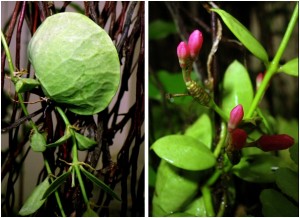
Dischidia vidalii
Also known as Dischidia pectinoides, it is better known by its common name the Ant Plant. It is perhaps the most common Dischidia species grown and sold locally. It produces numerous small, ornamental red flowers and is best known for its curious-looking, pouch-like modified leaves which are hollow, root-filled structures.
In its natural habitat, this plant is often associated with ants and the hollow modified leaves (affectionately called 'ant hotels') provide shelter for ants. In return, ants guard the plant and their excrement provide nutrients for their host.
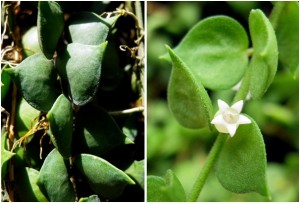
Dischidia ruscifolia
Commonly known as Million Hearts, this species of Dischidia has numerous small, heart-shaped leaves that line both sides of thin trailing stems. Its flowers are small and grow between a leaf and the stem (right).If grown under intense light, the plant's leaves will develop a red tinge.
In Singapore, the plant is sold in hanging pots where its stems trail over the rim of the pot or are wound round a heart-shaped frame ornament. Both versions often make their appearances around Valentine's Day.
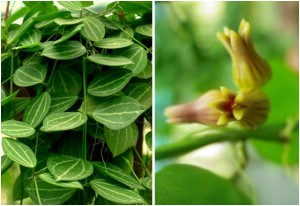
Dischidia ovata
This plant is commonly called the Watermelon Dischidia due to the appearance of its foliage - the leaves resemble watermelons with three stripes running across them. They often take on a nice reddish tinge when exposed to several hours of direct sunlight. Its flowers are small and produced between a leaf and the stem (right).
This plant is often presented in a hanging basket either with its stems trailing or wound round the basket supports.
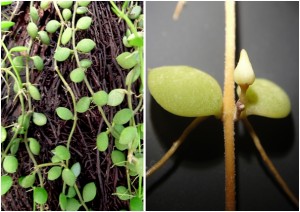
Dischidia nummularia
Dischidia nummularia are sometimes seen growing on old tree trunks. A native of Singapore, its common names include Pebble Beach and Button Orchid - a misnomer as it is not at all an orchid.
This plant has wiry stems adorned with tiny leaves shaped like convex magnifying lenses. Its flowers (above right) are small and often overlooked. Not commonly sold in nurseries, its stems are grown wound round pieces of driftwood or coconut husk chunks.
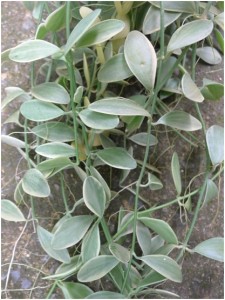
Dischidia oiantha
To date, this species does not have a common name. The variegated version (labelled as Dischidia ioantha 'Variegata') is more readily available for sale, probably due to its more showy and decorative appearance.
It features trailing stems with oval leaves with white edges. It is often grown with its long stems wound round some coconut husk chunks.
Growing Tips
Location
Dischidia species prefer a humid and well-ventilated location with at least half a day's exposure to filtered sunlight. They can tolerate a couple of hours of direct sunlight but plants must be well-watered under such conditions. Avoid growing them in an overly windy place as the plants will dry out very quickly.
Water & Growing Media
These plants are best grown in a moist and porous growing medium. The most common material used is coconut husk chunks. Being epiphytic in nature, they prefer to dry out a little between each watering. Avoid using soil-based growing media as they often hold too much water and become compacted.
Support
Climbing Dischidia species can be grown by winding the stems around its hanging pot's hangers, thin branches or a moisture-retentive, rough and porous surface, such as the bark of a tree. These may be cut back to prevent the plant from growing into places where they are not desired.
Propagation
Dischidia are easily propagated from stem-cuttings. Cut short segments of the stem and let them heal and dry. Then put them on top of some moist sphagnum moss - strings may be needed to secure them in place. The stem cuttings should be placed in a protected place away from direct sunlight and wind with the sphagnum moss kept moist at all times. Once roots have grown and the cuttings show some growth, they can be moved to their final locations.
The plants can also be grown from seeds which are produced in pods that split when mature. The seeds have fine hairs attached that enable the wind to carry them away.
By Dr Wilson Wong
Pictures of Dischidia vidalii, Dischidia nummularia, Dischidia ovata courtesy of NParks Flora and Fauna Web.
|
Author's Note:
|
Have views or comments on this article? Let us know via this form. If you would like to give us feedback on any other areas relating to our parks and gardens, please submit via https://www.nparks.gov.sg/feedback


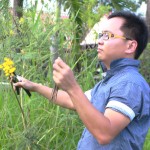
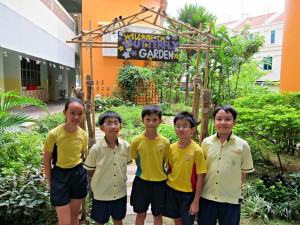
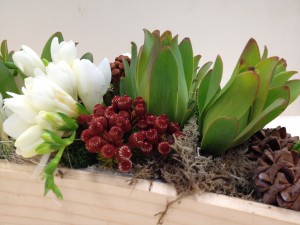

Pandy Silavut 3/25/2014 5:03:18 AM